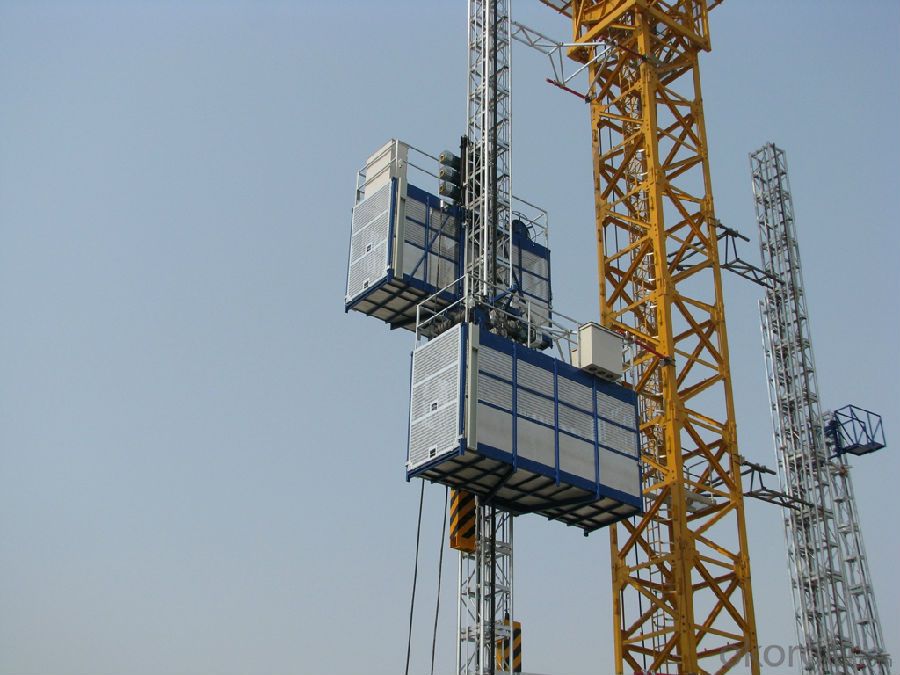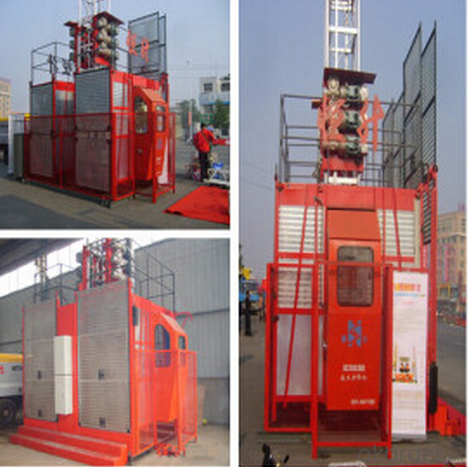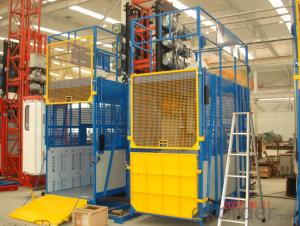Construction Machinery Building Passenger Hoist Elevator with CE
- Loading Port:
- China main port
- Payment Terms:
- TT OR LC
- Min Order Qty:
- 1 set
- Supply Capability:
- 1000 set/month
OKorder Service Pledge
OKorder Financial Service
You Might Also Like
Structure of Building Hoist
SC200/200 Construction Material Hoist
Out Enclosure Painted SC200 Yellow Material Construction Twin Cage Hoist 3.2 x 1.5 x 2.5m for Colombia.
Mingwei building hoist already have exported to the following countries: Indonesia , Brazil, Vietnam,Colombia,Sri Lanka.,etc.
Standard data of single and double cage :
Building hoist Specifiction
The newly designed computer controlled auto landing equipment, wireless floor call system and the overload alarming caller can be chosed by customers. The above three functions can be used alone or together according to the requirement of customers. The computer controlled auto landing equipment, wireless floor call and the overload alarming caller can be one computer controlling panel to realize the automatic operating.
| Model(single and double cage) | Capacity(kgs) | Lifting speed(m/min) | Motor power(kw) |
| SC100TD | 1000 | 36 | 2x11 |
| SC200TD | 2000 | 36 | 3x11 |
| SC270TD | 2700 | 36 | 3x15 |
| SC320TD | 3200 | 36 | 3x18.5 |
| SC100/100TD | 2x1000 | 36 | 2x2x11 |
| SC200/200TD | 2x2000 | 36 | 2x3x11 |
| SC270/270TD | 2x2700 | 36 | 2x3x15 |
| SC320/320TD | 2x3200 | 36 | 2x3x18.5 |
| SC100GZ | 1000 | 0-63 | 2x15 |
| SC200GZ | 2000 | 0-63 | 3x18.5 |
| SC270GZ | 2700 | 0-63 | 3x22 |
| SC200/200GZ | 2x2000 | 0-63 | 2x3x15 |
| SC270/270GZ | 2x2700 | 0-63 | 2x3x18.5 |
| SC320/320GZ | 2x3200 | 0-63 | 2x3x22 |
| SC100/100G | 2x1000 | 0-96 | 2x2x22 |
| SC200/200G | 2x2000 | 0-96 | 2x2x22 |
| SC270/270G | 2x2700 | 0-96 | 2x2x22 |
Building Hoist Images





FAQ of Building Hoist
Q: What is the building hoist main purpose?
A: Building hoist equipped with double or single cabin to transport the materials and labors up and down. It's the ideal
construction equipment for vertical transportation in the field of construction.
Q: What is the main structure of building hoist?
A: The P/M construction hoist mainly contains metal structure, driving system, electrical control system, cable guide &
protection system, electrical top crane and safety device.
Q: What is the meaning of the building hoist’s code?
A: Take SC200/200 for example: “SC” stands for rack and pinion hoist, “200/200” stands for double cage and capacity
is 2 tons per cage. “SC200” stands for single cage and capacity is 2 tons.
Q: What is the dimension of the cage?
A: Normally the cage dimension is 3X1.5X2.5M (L/W/H) for 2t type hoist. Details should be checked according to our
quotation sheet. Also, the size can be customized according to the factual site condition. There are two doors (entrance
& exit doors) for each cage, It can be produced as up & down sliding or ramping model for safety and convenience
- Q: Is it safe to use a building hoist for lifting heavy objects when there is wind?
- <p>Using a building hoist in windy weather is generally not recommended due to the increased risk of accidents. Wind can cause the hoist to sway, potentially leading to loss of control and dropping of the load. Safety guidelines typically advise against hoisting operations when wind speeds exceed certain limits, often around 20-30 miles per hour (32-48 kilometers per hour). It's crucial to check local regulations and the manufacturer's guidelines for the specific hoist model to determine safe operating conditions. Always prioritize safety and ensure that all necessary precautions are taken to secure the load and the hoist in windy conditions.</p>
- Q: This question asks about the measures taken to guarantee the safety and reliability of lifting equipment prior to its use in construction.
- <p>To ensure that lifting equipment is safe and reliable before using it in construction work, several key steps must be taken. Firstly, regular inspections and maintenance are crucial to identify any potential issues or wear and tear. Secondly, all equipment should be thoroughly tested and certified by qualified personnel to meet safety standards. Thirdly, proper training for operators is essential to ensure they understand how to use the equipment safely. Additionally, having a comprehensive safety plan in place, including emergency procedures, can help prevent accidents. Lastly, using equipment from reputable manufacturers and ensuring all components are in good working order are also vital for maintaining safety and reliability.</p>
- Q: The difference between the derrick and the construction elevator?
- You want the picture to still want to explain, the words to go to baidu search all can. The derrick is not to be multiplied by the person, the setting height is not more than 30 meters, now most of the place begin to phase out the use of the derrick, because the safety coefficient is low. The construction elevator can carry cargo, set up a height of 150 meters, and can carry a weight of 1-3 tons
- Q: How does the driver of the construction elevator do the search for a sudden power failure
- There are clear rules for the safety of construction machinery (JGJ33-2001). 6.12.17 when the elevator is running in an existing abnormal condition, it should stop immediately and take effective measures to reduce the cage down to the ground level, and keep running after the failure. When the electric is out of control in operation, the stop button should be pressed immediately. The stop button is not allowed until the failure is ruled out. 6.12.20 when elevator in the operation of the midway stop due to power outages or other reasons, can be manually, the end of a motor brake electromagnet manual release slowly shake handshandle pull outward, slowly slide down the ladder cage, ladder cage fall shall not exceed the rated speed, manually drop must be conducted by professional maintenance personnel manipulation.
- Q: Is it possible to substitute an automatic lifting device with a manual one in construction projects?
- <p>While it is technically possible to use a manual lifting device in place of an automatic one for certain construction tasks, it is not generally recommended. Manual lifting devices are typically less efficient, slower, and can pose safety risks due to the physical effort required. They may also not meet the load-bearing requirements of heavy construction materials. Automatic lifting devices are designed for efficiency, safety, and to handle heavy loads, making them more suitable for construction work. It's crucial to adhere to safety standards and use appropriate equipment for the task at hand.</p>
- Q: Is it possible to operate building hoists in cold weather conditions?
- <p>Yes, building hoists can be used in cold climates, but they must be designed and maintained for such conditions. Cold weather can affect the performance of hoists, so it's crucial to use hoists specifically engineered for low-temperature operation. Regular maintenance and checks are necessary to ensure safety, as extreme cold can cause metal parts to contract and lubricants to thicken, affecting the hoist's functionality. Always follow the manufacturer's guidelines for operating hoists in cold climates.</p>
- Q: Can a building hoist be utilized for moving objects that exceed manual lifting capabilities in terms of height and width?
- <p>Yes, building hoists are designed to move objects that are too tall or too wide for manual lifting. They are engineered to handle heavy and oversized items safely and efficiently, overcoming the limitations of manual labor. Building hoists can be used in construction to lift materials to various floors, and in other industries for moving large equipment or components that are not feasible to lift by hand. They are an essential tool for safely managing the movement of large-scale objects in a controlled manner.</p>
- Q: This question asks for a comparison between electric and hydraulic building hoists, highlighting their main differences.
- <p>Electric building hoists are powered by electricity and use electric motors to lift and lower loads. They are generally quieter, require less maintenance, and can be more energy-efficient. Hydraulic building hoists, on the other hand, use hydraulic pressure to move loads. They tend to be more powerful and can lift heavier loads, but they may require more maintenance and are not as energy-efficient. Electric hoists are often preferred for lighter loads and indoor use, while hydraulic hoists are chosen for heavy-duty applications and outdoor use where power is not readily available.</p>
- Q: This question asks for guidance on selecting an appropriate building hoist for specific requirements.
- <p>Choosing a suitable building hoist involves several considerations. First, assess the load capacity needed based on the weight of materials to be lifted. Consider the hoist's lifting height to ensure it covers the building's full height. Evaluate the frequency of use and the speed required for efficient material movement. Safety features are crucial; look for hoists with certifications and safety mechanisms like overload protection. Check the hoist's durability and maintenance requirements. Finally, consider the cost, including purchase price, operation, and maintenance expenses. Consulting with hoist manufacturers or rental companies can provide personalized advice tailored to your project's specific needs.</p>
- Q: Is it possible to utilize a building hoist to lift objects with varying dimensions and weights?
- <p>Yes, building hoists are designed to lift a variety of objects with different sizes and weights. However, each hoist has specific weight and size limitations that must be adhered to for safety and operational reasons. It's crucial to ensure that the objects being lifted are within the hoist's capacity to prevent accidents and damage. Always consult the manufacturer's specifications and safety guidelines before using a hoist for lifting operations.</p>
Send your message to us
Construction Machinery Building Passenger Hoist Elevator with CE
- Loading Port:
- China main port
- Payment Terms:
- TT OR LC
- Min Order Qty:
- 1 set
- Supply Capability:
- 1000 set/month
OKorder Service Pledge
OKorder Financial Service
Similar products
Hot products
Hot Searches
Related keywords
































